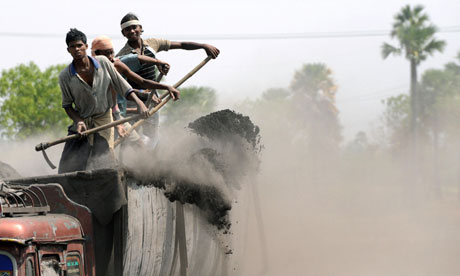Energy generated from new coal-power stations in this single state could eclipse emissions from an entire country
A single Indian state is to build a new fleet of coal-power stations that could make it one of the world’s top 20 emitters of carbon emissions – on a par with countries such as Spain or Poland. The proposed coal plants in the south-eastern state of Andhra Pradesh are part of a wider Indian “coal rush” to bring power to the country’s hundreds of millions living without electricity. They face opposition from local people and environmental NGOs who warn of farmland being turned over to opencast mines and coasts being threatened with pollution from ports that will handle coal.

Indian labourers unload coal powder on the outskirts of Hyderabad, capital of the state Andhra Pradesh. Photograph: Noah Seelam/AFP/Getty Images
In an echo of the Chinese economy in the 1990s which depended on the exploitation of vast reserves of coal, India last year approved plans for 173 coal-fired power stations expected to provide an extra 80-100 gigawatts (GW) of electricity capacity within a few years. Many are expected to be fuelled by cheap coal imported from Australia, Indonesia and southern Africa, but applications to mine more than 600m tonnes of coal in India have been lodged.
The epicentre is Andhra Pradesh which, with a population is 84.7 million people, is now expanding its power production by 800%. Seven major and more than 30 smaller coal-powered power stations are planned, together intended to have a capacity of 56GW. In comparison, the UK’s installed electricity capacity is 75GW, but is expected to rise to 100GW in the next two decades. The largest plant, expected to be opened in two years, will be the $4bn Krishnapatnam power station, India’s first “ultra-mega” class of coal-fired power station. With 4GW, capacity it will be one of the world’s 25 biggest electricity sources, capable of powering 7m middle-class homes.
But, say activists, the Indian coal rush is being met by opposition, deaths and violent repression. Local protesters in Andra Pradesh say that the power will mostly be exported to large cities, heavy industry and neighbouring states, while local people are left with a legacy of pollution and toxic dumps.
“In many areas locals have protested against proposed coal plants,” Babu Rao, a former Indian government official turned anti-coal activist, said in a statement. “We have had several reports of the police reacting violently against protesters, intimidating villagers, as they struggle to protect their livelihood and habitats.”
“The sheer scale of this expansion has left local communities to bear the brunt of an increasingly violent onslaught of land acquisition and displacement, corruption and intimidation, and a toxic legacy of localised pollution,” Justin Guay, of the US Sierra Club’s International climate programme, blogged recently.
But India’s breakneck economic development has also led to protests over power shortages in cities and industries unable to meet orders.
Growing frustration at the government’s decison to block the expansion of coal mines in some of India’s most heavily polluted coalfield areas is thought to have contributed to this week’s removal of Jairam Ramesh from the environment ministry.
Ramesh was widely blamed by the coal and power ministries for delaying mine expansion approvals and for India not meeting its coal production targets. Ramesh relaxed rules for coal developers under intense pressure in the days before he was moved, but bans on new mining in several hundred blocks with a potential of over 600m tonnes of coal remain.
Separately this week, international watchdog groups also complained that Indian coal companies were trying to earn hundreds of millions of carbon credits from the coal expansion. The Krishnapatnam plant has been registered with the UN clean development mechanism (CDM) and, if approved, could generate 3.5m carbon credits a year.
Eva Filzmoser, director of the CDM Watch group in Germany, wrote in a recent statement: “The registration of the coastal Andhra project brings the total number of coal projects registered to five, representing roughly 68m credits worth over €680m. With another 31 projects in the pipeline, potentially generating hundreds of millions of artificial credits worth billions of euros in windfall profits, there is an urgent need to suspend this methodology.”
Reliance, the plant owner, says that UN funds are needed to build a plant using the most advanced anti pollution technology but critics counter that India’s “ultra mega”-sized plants must by law be equipped with such equipment.
 Follow
Follow